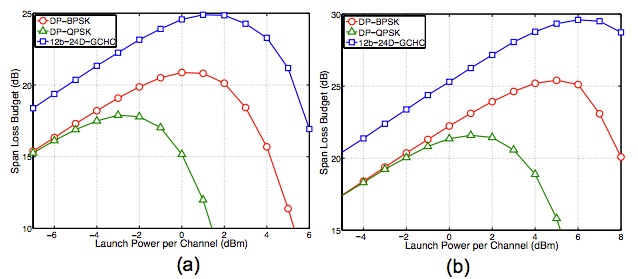TR2013-134
A 24-Dimensional Modulation Format Achieving 6 dB Asymptotic Power Efficiency
-
- , "A 24-Dimensional Modulation Format Achieving 6 dB Asymptotic Power Efficiency", Signal Processing in Photonic Communications (SPPCom), July 2013.BibTeX TR2013-134 PDF
- @inproceedings{Millar2013jul,
- author = {Millar, D.S. and Koike-Akino, T. and Kojima, K. and Parsons, K.},
- title = {{A 24-Dimensional Modulation Format Achieving 6 dB Asymptotic Power Efficiency}},
- booktitle = {Signal Processing in Photonic Communications (SPPCom)},
- year = 2013,
- month = jul,
- url = {https://www.merl.com/publications/TR2013-134}
- }
- , "A 24-Dimensional Modulation Format Achieving 6 dB Asymptotic Power Efficiency", Signal Processing in Photonic Communications (SPPCom), July 2013.
-
MERL Contacts:
-
Research Area:

Abstract:
Although 4-dimensional (4D) modulation formats have been known to the optical communications community since the early days of coherent detection [1], the recent work of Agrell and Karlsson [2,3], has led to a great deal of interest in optimized constellations in 4D. These modulation formats can achieve substantial gains compared with conventional formats such as dual-polarization quaternary phase-shift keying (DP-QPSK) and 16-ary quadrature amplitude modulation (DP-16QAM). For example, polarization-switched QPSK (PS-QPSK) [4], and set-partitioned 128-ary QAM (SP-128QAM) [5], achieve 1.76 dB and 2.43 dB gains in asymptotic power efficiency, respectively. Experimental results have demonstrated gains of up to 1.5 dB in the forward-error correction (FEC) limit regimes [6, 7]. While higher-dimensional modulations have been investigated for many years [8,9], their application to optical communications has been limited to 4D case.
In this paper, we investigate the performance of a 24D format based on mapping the codewords of the extended Golay code [10], onto a 24D hypercube, achieving a spectral efficiency of 1 b/s/Hz/pol. We refer to this format as 12-bit 24D Golay coded hypercube (12b-24D-GCHC). Tolerance to additive white Gaussian noise (AWGN) is found to be better than dual-polarization binary PSK (DP-BPSK) by 3 dB at a BER of 10^ -3, and 1.9 dB at a BER of 10^ -2. Transmission performance is simulated over a link of 50 spans of standard single mode fiber (SSMF) with erbium doped fiber amplification (EDFA) both with and without inline optical dispersion compensation, and 12b-24D-GCHC is compared to DP-BPSK and DP-QPSK. We find an increase in maximum tolerable span loss of at least 4 dB compared to DP-BPSK and 8 dB compared to DP-QPSK.

